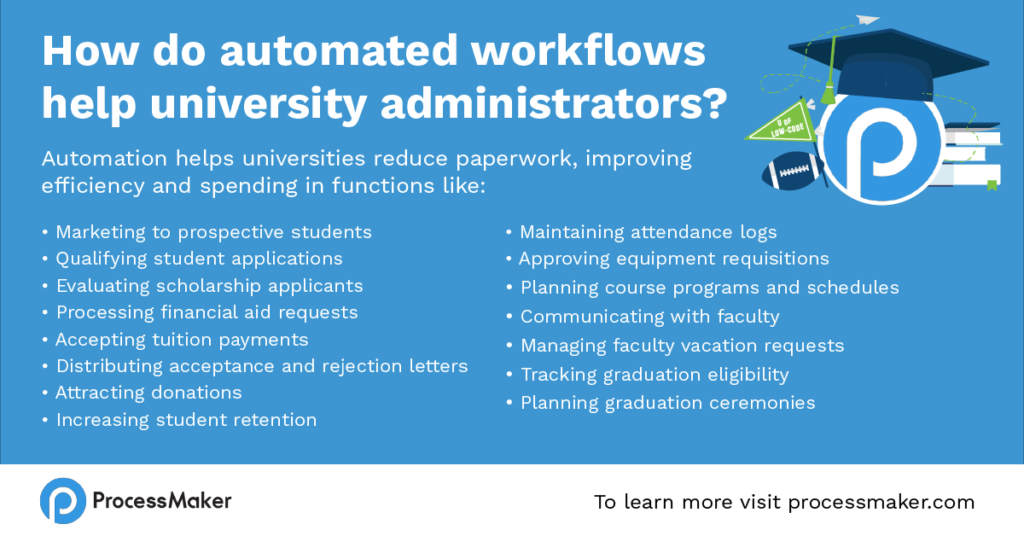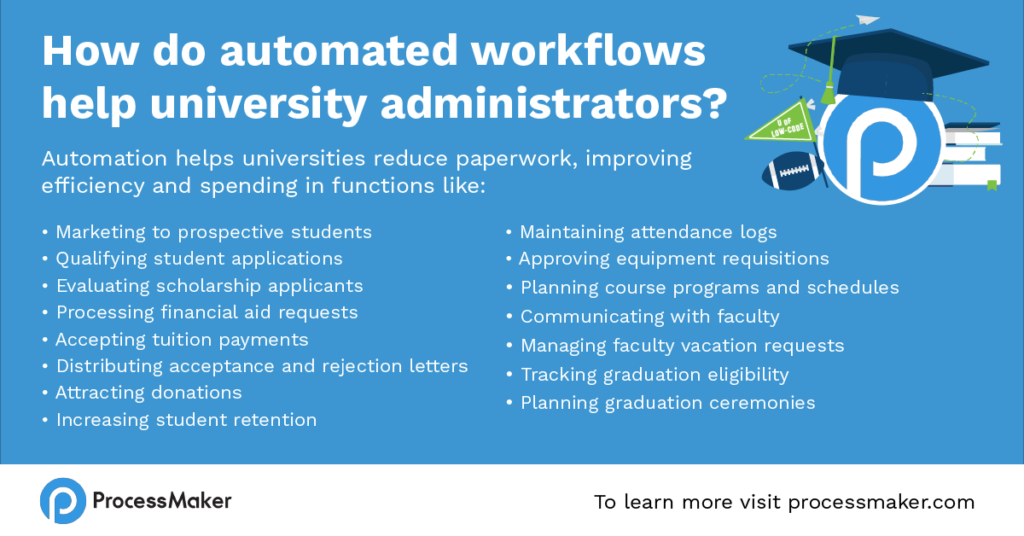Guide to Workflow Automation in Education
Blog: ProcessMaker Blog
Journalists and economy experts are challenging universities to prepare students for the future of automated work. Educators are rising to the challenge, pumping curricula full of new courses and degrees like industrial automation, data science, and business process management. But, when it comes to upgrading their own operations—how universities run day-to-day—the power of workflow automation is often overlooked. For top-performing institutions, it’s a proven competitive advantage that improves efficiency, reduces costs, and grants faculty more bandwidth to create an engaging student experience.
Why is workflow automation in education important?
Students, the customers of the higher education system, are just like consumers in any other sector—they value convenience above all. Smartphones are the magic wands that can order food, hail a ride, and even accept job applications. Yet many higher education administrators are still frustrating students with paper-based forms and checks for payment.
Convoluted, manual processes are also a bane of productivity for educators and staff. One report revealed that collegiate faculty spend 30% of their time on paperwork and administrative housekeeping.
Enter workflow automation. With this technology, you can condense fifty manual steps down to ten—many of which can run without human intervention. Paperwork files itself neatly in digital cabinets that you can access from anywhere in the world. Documents move between approving parties automatically, without the need for face-to-face exchange. Departments no longer work in a silo but freely exchange information, seamlessly accessible from a central hub. Students can access campus and registrar services via apps, and chatbots answer quick questions from prospects browsing college options.
In a study by Ernst & Young, researchers found that automation reduced process touchpoints at one university from 40 to 1, reducing the workload on educators by up to 13 hours per week. With powerful results like these, it’s no surprise that 63% of higher education institutions are now using workflow automation tools.
How do automated workflows help university administrators?

Automation helps universities reduce paperwork, improving efficiency and spending in functions like:
- Marketing to prospective students
- Qualifying student applications
- Evaluating scholarship applicants
- Processing financial aid requests
- Accepting tuition payments
- Distributing acceptance and rejection letters
- Attracting donations
- Increasing student retention
- Maintaining attendance logs
- Approving equipment requisitions
- Planning course programs and schedules
- Communicating with faculty
- Managing faculty vacation requests
- Tracking graduation eligibility
- Planning graduation ceremonies
Fortunately for universities, many of these processes are repetitive—a pain for human workers but a boon for automated software. You can easily codify the sequence of events so workflow automation platforms can perform them independently.
Popular examples of how colleges and universities are using workflow automation to take advantage of tech trends
Imagine what your best minds could do if they could focus more on creating an enjoyable, prosperous student experience than paperwork. Universities are using automation to free up faculty by turning time-consuming tasks over to software. Here are some popular ways they’re fighting back against the 2–4 hours a day wasted on toilsome manual work.
Attract new students
Top higher-ed institutions are using workflow automation to better market to prospective students. Instead of fielding thousands of email and phone call questions, universities are turning to virtual assistants and chatbots. When a particular question piques an interested student, they can ask a 24/7 website chatbot for an instant answer. Some institutions report fielding upwards of 40,000 questions—a significant time-saver for overworked administrators.
Streamline course registration
Class registration requires connecting data from multiple departments: bursar (are tuition payments up to date?), scheduling (what days and times are courses taking place?), the registrar (what courses are required by this degree?), and more. Automated workflows can bring all of this information together into a sequence of automated steps. Some colleges even use machine learning tools to help propose schedules that fit a student’s individual needs.
Accept online payments
In 2019, over 64 million Americans used their smartphones to make a mobile payment. From tuition to football tickets, books, and late-night snacks, today’s students expect the same convenience on campus. Universities that offer the perk report that fewer manual payments allow bursars to spend less time opening mail and more time focused on student support. But, only 29% of universities offer it. By introducing mobile payment options into your university workflow—one that integrates information from financial aid, the bursar’s office, and more—you can offer campus-wide convenience for students and faculty.
How to get started with your university’s workflow automation plan
Like introducing any new initiative, an effective automation strategy starts with a solid plan.
Identify the strongest candidates for automation on your campus
Not every sequence of tasks is suitable for automation. Those that are repeatable, manual, and especially time-draining are the ideal places to start. Look out for these common activities:
- Frequent and repetitive tasks
- Copying and pasting data between systems
- Manual forms or applications
- Compiling reports
- Scheduling of sales outreach
- Coordinating approvals
How do you pare down the list? Tasks that occur frequently should be your top targets: automating tasks that crop up daily will save more time than quarterly tasks.
Focus on areas that improve the student experience
While many tasks can decrease faculty workload, it’s critical to start with those that address the needs of your customer—the students. A chatbot that wholly eliminates incoming calls might sound appealing at face value. But, if used too heavy-handedly, it takes away from the in-depth conversations that foster strong relationships. Identify tasks that, if eliminated, will help boost, not erode, your connection with students.
Once you’ve identified and vetted the right processes, you can start exploring exactly how your team performs each step of the process.
Evaluate workflows and create a process map
Now that you’re ready with a list of the most effective targets for automation, it’s time to evaluate how you can best execute them. Start by asking around. Interview the very staff members responsible for each function to better understand the steps involved in each process. Consider sitting in for a day to study precisely how each staffer performs tasks, and then follow the breadcrumbs. When a process connects to a database or a faculty member in another department, identify the responsible party and analyze their procedures, too. Using a process modeler, you can effectively map every step of the entire process from start to finish.
Automation is changing every industry it touches, from manufacturing to marketing and banking. Colleges and universities are actively folding automation into course programs, teaching students how to leverage this powerful tool in the workforce. Top-performing higher-ed administrators are also recognizing its vast potential for improving campus-wide operations. Is your university read to launch your automation strategy?
The post Guide to Workflow Automation in Education appeared first on ProcessMaker.
Leave a Comment
You must be logged in to post a comment.








